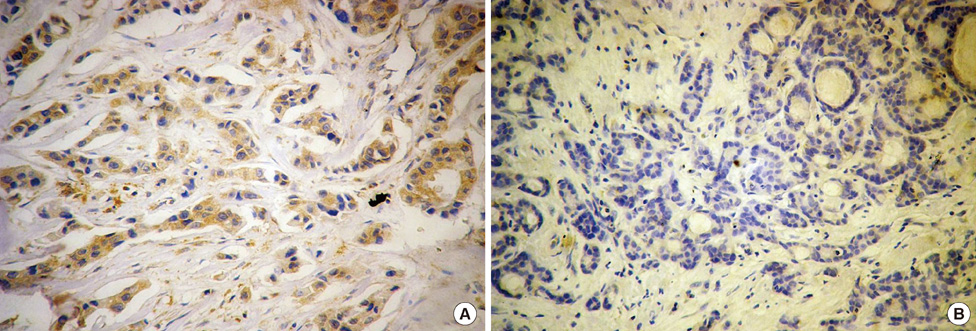J Breast Cancer.
2011 Sep;14(3):185-190.
G-protein Coupled Estrogen Receptor 1 Expression in Primary Breast Cancers and Its Correlation with Clinicopathological Variables
- Affiliations
-
- 1Department of Endocrine and Breast Surgery, The First Affiliated Hospital, Chongqing Medical University, Chongqing, China. luoasa2010@gmail.com
- 2Department of Laboratory Medical Diagnosis, The Ministry of Education Key Laboratory of Laboratory Medical Diagnosis, Chongqing Medical University, Chongqing, China.
Abstract
- PURPOSE
G-protein coupled estrogen receptor 1 (GPER) probably play important roles in the progression of breast cancer including endocrine therapeutic resistance. We evaluated GPER in primary breast cancers.
METHODS
Immunohistochemistry was used to detect GPER in paraffin-embedded tissues of primary breast cancers from 423 patients and GPER expression was correlated with clinicopathological factors.
RESULTS
GPER was expressed in 63.8% of specimens, coexpressed with estrogen receptor alpha (ERalpha) in 36.6% of tumors and was positive in 62.5% of the ERalpha-negative tumors. The expression of GPER had no relationship with the status of ERalpha, progesterone receptor and HER2. Although the expression of GPER was significantly inversely related with nodal status (p=0.045), no correlation between GPER expression and other clinicopathological variables (age, menstruation status, tumor size, stage, histologic grade, Nottingham Prognostic Index or pathological type) was found.
CONCLUSION
GPER and ERalpha exhibited independent expression pattern of distribution in primary breast cancers. A long-term follow-up and a more definite molecular phenotype for ER are necessary in confirming studies.
MeSH Terms
Figure
Reference
-
1. Early Breast Cancer Trialists' Collaborative Group (EBCTCG). Effects of chemotherapy and hormonal therapy for early breast cancer on recurrence and 15-year survival: an overview of the randomised trials. Lancet. 2005. 365:1687–1717.2. Prossnitz ER, Sklar LA, Oprea TI, Arterburn JB. GPR30: a novel therapeutic target in estrogen-related disease. Trends Pharmacol Sci. 2008. 29:116–123.
Article3. Thomas P, Pang Y, Filardo EJ, Dong J. Identity of an estrogen membrane receptor coupled to a G protein in human breast cancer cells. Endocrinology. 2005. 146:624–632.
Article4. Ignatov A, Ignatov T, Roessner A, Costa SD, Kalinski T. Role of GPR30 in the mechanisms of tamoxifen resistance in breast cancer MCF-7 cells. Breast Cancer Res Treat. 2010. 123:87–96.
Article5. Pandey DP, Lappano R, Albanito L, Madeo A, Maggiolini M, Picard D. Estrogenic GPR30 signalling induces proliferation and migration of breast cancer cells through CTGF. EMBO J. 2009. 28:523–532.
Article6. Quinn JA, Graeber CT, Frackelton AR Jr, Kim M, Schwarzbauer JE, Filardo EJ. Coordinate regulation of estrogen-mediated fibronectin matrix assembly and epidermal growth factor receptor transactivation by the G protein-coupled receptor, GPR30. Mol Endocrinol. 2009. 23:1052–1064.
Article7. Lapensee EW, Tuttle TR, Fox SR, Ben-Jonathan N. Bisphenol A at low nanomolar doses confers chemoresistance in estrogen receptor-alpha-positive and -negative breast cancer cells. Environ Health Perspect. 2009. 117:175–180.
Article8. Smith HO, Arias-Pulido H, Kuo DY, Howard T, Qualls CR, Lee SJ, et al. GPR30 predicts poor survival for ovarian cancer. Gynecol Oncol. 2009. 114:465–471.
Article9. Smith HO, Leslie KK, Singh M, Qualls CR, Revankar CM, Joste NE, et al. GPR30: a novel indicator of poor survival for endometrial carcinoma. Am J Obstet Gynecol. 2007. 196:386.e1–386.e9.
Article10. Filardo EJ, Graeber CT, Quinn JA, Resnick MB, Giri D, DeLellis RA, et al. Distribution of GPR30, a seven membrane-spanning estrogen receptor, in primary breast cancer and its association with clinicopathologic determinants of tumor progression. Clin Cancer Res. 2006. 12:6359–6366.
Article11. Leake R, Barnes D, Pinder S, Ellis I, Anderson L, Anderson T, et al. Immunohistochemical detection of steroid receptors in breast cancer: a working protocol. UK Receptor Group, UK NEQAS, The Scottish Breast Cancer Pathology Group, and The Receptor and Biomarker Study Group of the EORTC. J Clin Pathol. 2000. 53:634–635.
Article12. Revankar CM, Cimino DF, Sklar LA, Arterburn JB, Prossnitz ER. A transmembrane intracellular estrogen receptor mediates rapid cell signaling. Science. 2005. 307:1625–1630.
Article13. Kuo WH, Chang LY, Liu DL, Hwa HL, Lin JJ, Lee PH, et al. The interactions between GPR30 and the major biomarkers in infiltrating ductal carcinoma of the breast in an Asian population. Taiwan J Obstet Gynecol. 2007. 46:135–145.
Article14. Tu G, Hu D, Yang G, Yu T. The correlation between GPR30 and clinicopathologic variables in breast carcinomas. Technol Cancer Res Treat. 2009. 8:231–234.
Article15. Arias-Pulido H, Royce M, Gong Y, Joste N, Lomo L, Lee SJ, et al. GPR30 and estrogen receptor expression: new insights into hormone dependence of inflammatory breast cancer. Breast Cancer Res Treat. 2010. 123:51–58.
Article16. Chen JQ, Russo J. ERalpha-negative and triple negative breast cancer: molecular features and potential therapeutic approaches. Biochim Biophys Acta. 2009. 1796:162–175.
Article17. Dennis MK, Burai R, Ramesh C, Petrie WK, Alcon SN, Nayak TK, et al. In vivo effects of a GPR30 antagonist. Nat Chem Biol. 2009. 5:421–427.
Article18. Levin ER. G protein-coupled receptor 30: estrogen receptor or collaborator? Endocrinology. 2009. 150:1563–1565.
Article19. Lappano R, Rosano C, De Marco P, De Francesco EM, Pezzi V, Maggiolini M. Estriol acts as a GPR30 antagonist in estrogen receptor-negative breast cancer cells. Mol Cell Endocrinol. 2010. 320:162–170.
Article20. Filardo EJ, Quinn JA, Frackelton AR Jr, Bland KI. Estrogen action via the G protein-coupled receptor, GPR30: stimulation of adenylyl cyclase and cAMP-mediated attenuation of the epidermal growth factor receptor-to-MAPK signaling axis. Mol Endocrinol. 2002. 16:70–84.
Article
- Full Text Links
- Actions
-
Cited
- CITED
-
- Close
- Share
- Similar articles
-
- Expression of bcl-2 and Apoptosis and Its Relationship to Clinicopathological Prognostic Factors in Breast Cancer - A Study with Long Term Follow-up
- Expression of Cyclooxygenase-2 in Human Breast Carcinoma: Relevance to Tumor Angiogenesis and Expression of Estrogen Receptor
- Comparison of estrogen receptor beta expression between breast cancer and normal mammary tissue and relationship with clinicopathological factors
- Significance of Expression of p16, Cyclin D1, Rb, and p53 Protein and Correlation with Clinicopathologic Prognostic Factors in Invasive Ductal Carcinoma of the Breast
- Cyclin D1 Expression in Primary Breast Carcinoma: Correlation with Estrogen Receptor Status and Other Clinicopathologic Parameters


